Do you want more views on your YouTube videos? Wondering how to get more people to click on your YouTube suggested videos?
In this article, you'll discover how your YouTube click-through rate (CTR) impacts video views and find six steps to improve your YouTube click-through rate.
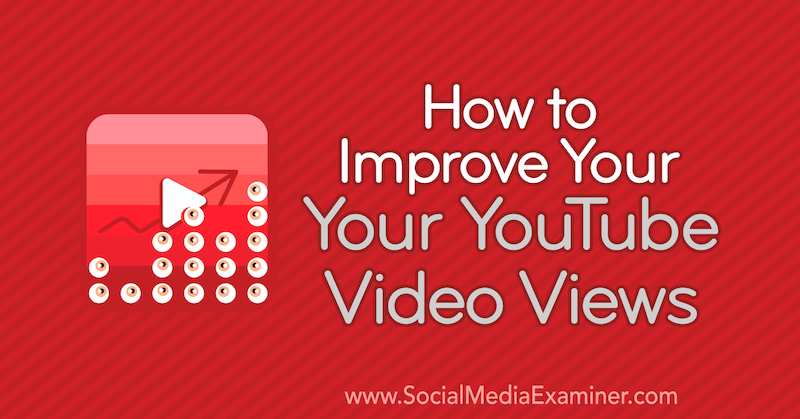
Why YouTube Click-Through Rate Is Important
Five hundred hours of video are uploaded to YouTube every minute, which means the platform needs to be very selective about what content they promote. If you want to grow your YouTube channel and improve visibility, CTR is one of the top metrics to focus on. It's the number of people who click on your video when they see it appear on YouTube. To illustrate, if your video gets 1,000 impressions and 100 people click on it, you have a CTR of 10%.
If your CTR is very low, YouTube will stop suggesting your video to people. If it's high, the platform will give it more reach. Here's how CTR is reported on in YouTube Analytics.
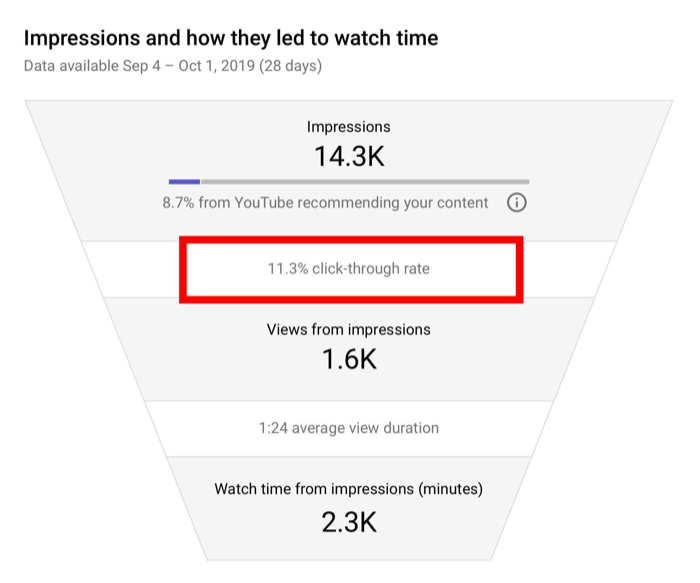
You can only build CTR on YouTube from impressions on:
- Search
- Suggested views
- The home screen
- The sidebar
YouTube does not log your CTR when a video gets viewed:
- On a website
- Through an endscreen
- When embedded in a social timeline
- Through push notifications
Any time you publish a new YouTube video, your goal should be to get as many clicks per impression as possible in the first 48 hours. This lets YouTube know people care about your content. The image below shows an initial 48-hour promotion burst.
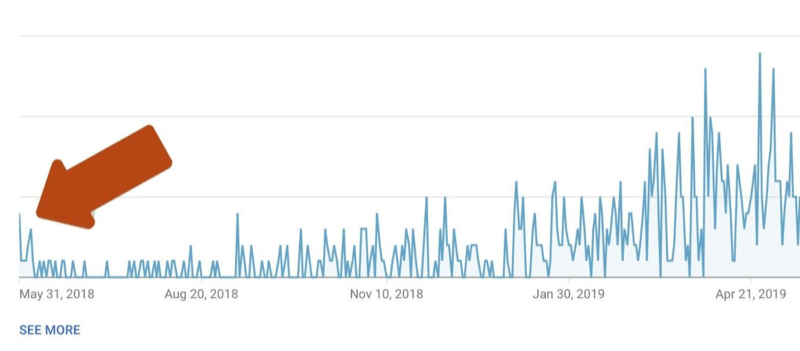
To understand why CTR is such a vital metric, you need to understand how YouTube works. For the platform to grow and dominate the world of online video, it needs to provide an amazing experience to users. That means showing the best content first. The platform works out what's good and what's not by using two additional metrics: watch time and audience retention.
YouTube Watch Time and Audience Retention
Watch time is almost always touted as the key stat to measure on YouTube, with good reason. YouTube uses it to judge the quality of your content and channel.
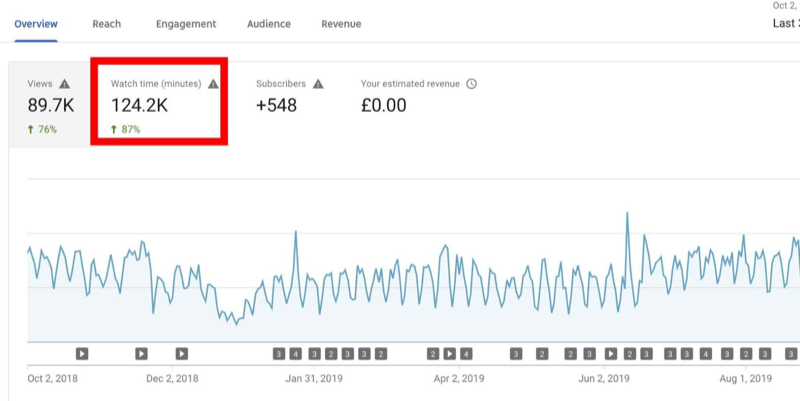
Suppose someone spends 10 minutes watching your video on “How to Build a Business,” but another video on the same topic only keeps people watching for 3 minutes. This data signals to the algorithm that the video with the higher watch time should be moved up in search ranking or suggested to more people.
Get World-Class Marketing Training — All Year Long!
Are you facing doubt, uncertainty, or overwhelm? The Social Media Marketing Society can help.
Each month, you’ll receive training from trusted marketing experts, covering everything from AI to organic social marketing. When you join, you’ll also get immediate access to:
- A library of 100+ marketing trainings
- A community of like-minded marketers
- Monthly online community meetups
- Relevant news and trends updates
Longer view times signal better content. Additionally, if someone then watches another of your videos right away, it gives your whole channel more watch time, signaling to the algorithm that your channel's content is high-quality, too.
To understand audience retention, let's revisit the “How to Build a Business” video example. While the watch time is a signal that the longer video was of higher quality, the shorter video might actually be better. To make sure YouTube doesn't promote a low-quality long video over a higher-quality short one just because it gets a longer watch time, it uses the measurement called audience retention.
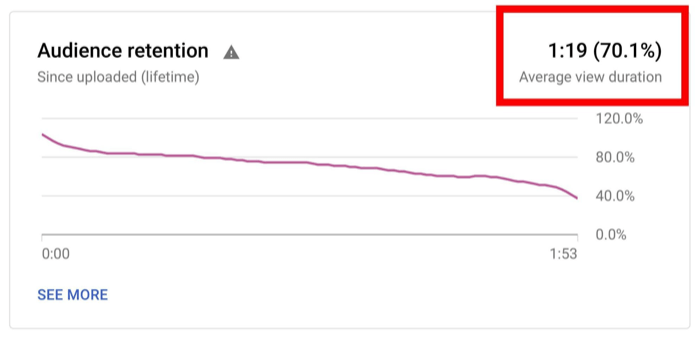
Audience retention is the percentage of a video that gets watched. So if on average people watch 20% of a 19-minute video and 90% of a shorter 3-minute one, it's a sign that the shorter one was a better experience for viewers.
YouTube uses watch time and audience retention together to help decide what it promotes.
Where CTR Fits in
You can now see why watch time and audience retention are vital on YouTube. But no matter how amazing your video content is, without people wanting to click on it, you can't build watch time or audience retention. This means you need to stand out on the platform so people will click on your content. Then watch time and audience retention will come into play.
Even though YouTube states, “Half of all channels and videos on YouTube have an impressions CTR that can range between 2% and 10%,” it's not particularly helpful. There's no exact percentage that's considered a good CTR. You're better off keeping an eye on your average channel CTR and always aim to beat it. Once YouTube has picked up the right signals from your content, they'll start pushing you up the ranks.
CTR is often highest right after upload when your most passionate fans and subscribers dive in to see the new video. This image shows a significantly higher CTR on the first day of release as a result of that.
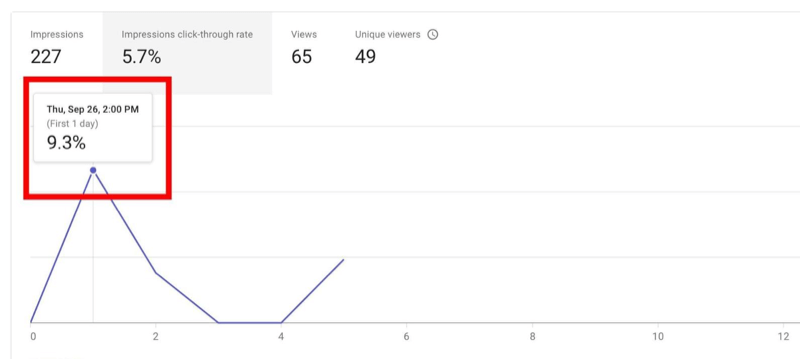
If your content rocks and has a good watch time, audience retention, and CTR, YouTube will show it to a broader audience, meaning you'll get more impressions.
If you somehow go viral, your content will be pushed out to a huge number of people all over the platform. But this new, broader audience may not have the same interest in your niche so while you might get more impressions and views, you'll likely see a decrease in your CTR. Therefore, lower CTRs on popular videos are nothing to worry about. If they're pulling in the views, then your CTR, watch time, and audience retention have worked as planned already.
#1: Find Your YouTube Channel and Individual Video CTR
First, let's look at how to check the CTR for your YouTube channel and individual videos.
To find your overall average channel CTR, go to YouTube Studio and select Analytics in the left navigation.
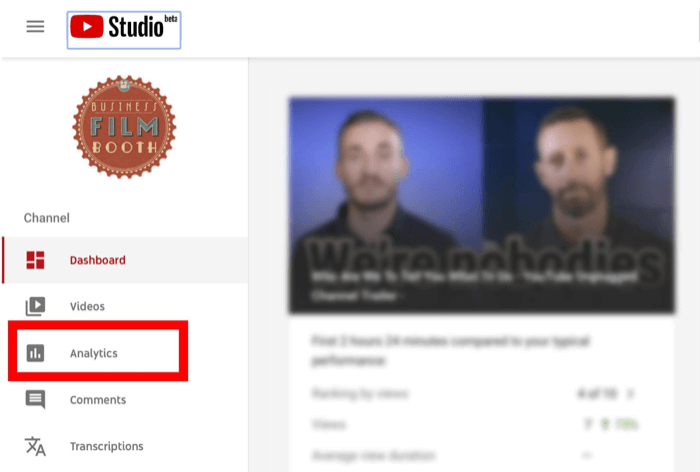
Then click the Reach tab and choose the time frame you want to focus on in the upper-right corner.
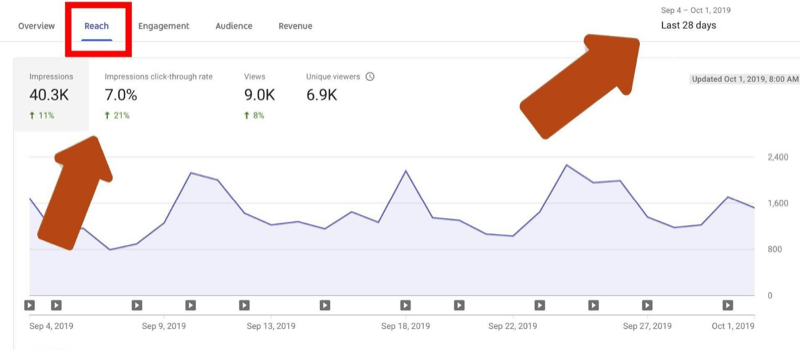
To find an individual video's CTR, open YouTube Studio and select the video you want to learn more about.
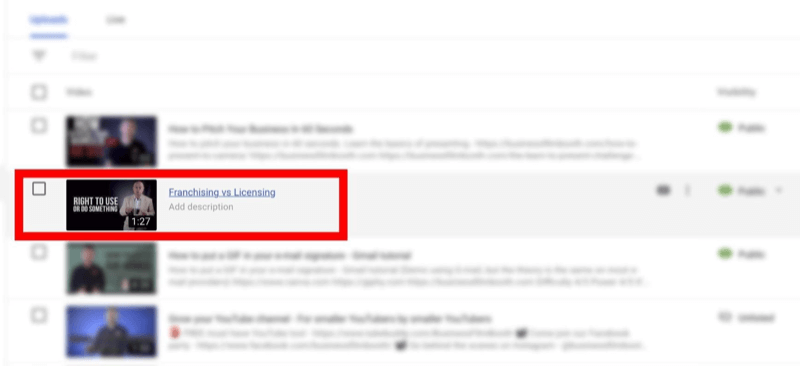
Click Analytics in the left navigation and choose Reach to see that individual video's reach.
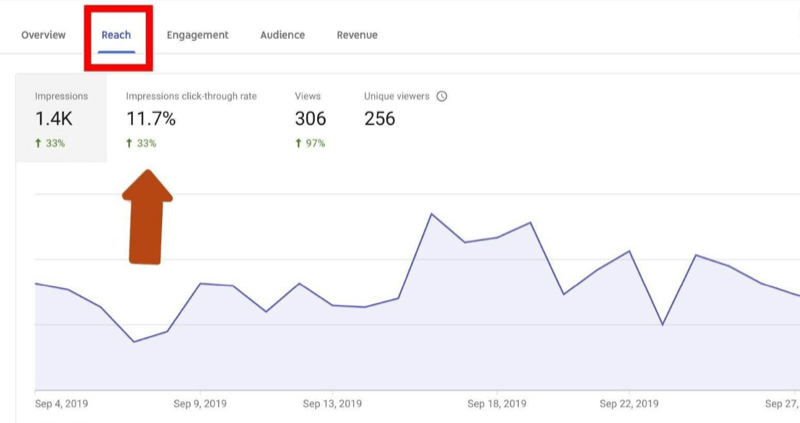
Pro Tip: Keep an eye on your best-performing YouTube videos. If the views begin to drop, check your CTR. You might find new competition has entered the market and knocked you down the ranks, reducing CTR.
Now that you know how to find your CTR in YouTube Analytics, let's look at some ways to increase the CTR of your YouTube videos.
#2: Zero in on Your Niche and YouTube Target Audience
To increase your CTR and project your video across YouTube, you need a loyal following. Making sure your channel has a clear niche and target audience is how you build one.
If one day you're making YouTube videos about cars and the next knitting, your subscribers—the people who are most likely to click on a new video in that crucial first 48 hours—will start to ignore you. Why? Because the chances are the knitters don't care about cars and the car enthusiasts don't care about knitting sweaters.
Focus on one specific topic and you'll get significantly higher CTR. To illustrate, if you're in marketing, you might pick an area like Facebook ads to start. Then narrow that down to using video in Facebook ads.
Over time, you might become known as the Facebook video pro. Once your channel is established and you've built a following, you'll have the right audience at your fingertips to promote more general Facebook content to.
By homing in on your niche, you'll get fewer views to start but they'll be more focused, helping you achieve a better CTR and higher rankings in YouTube search. You'll also build the foundation on which your channel can grow.
#3: Use Tools to Research YouTube Video Titles
The next area we want to look at is YouTube video titles. To present your titles in a way that people will want to click on them, you need to research the terms people are already using to search for content like yours.
Ubersuggest is a free tool that tracks search terms on Google but it can also be useful for YouTube. The two platforms are part of the same company and they're used in the same way.
Ubersuggest is easy to use. Type in the topic or title you're considering as a starting point, and it will show:
- The number of monthly searches
- Other keyword ideas
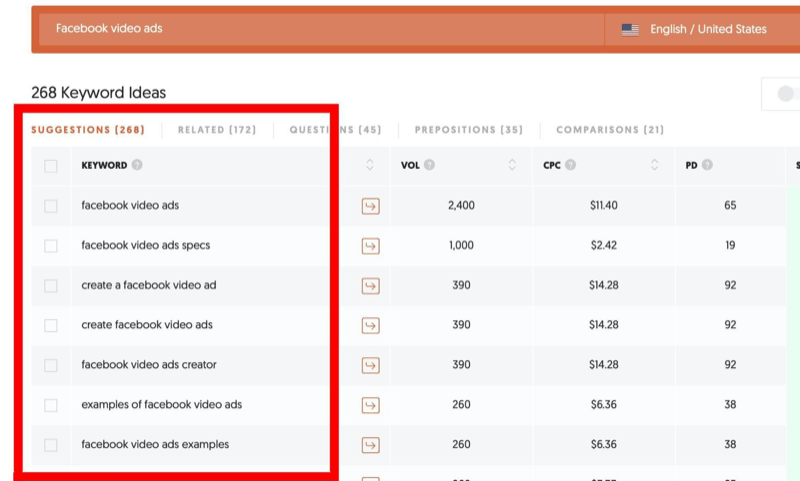
- How competitive your keywords are
- The top-ranking articles for that term
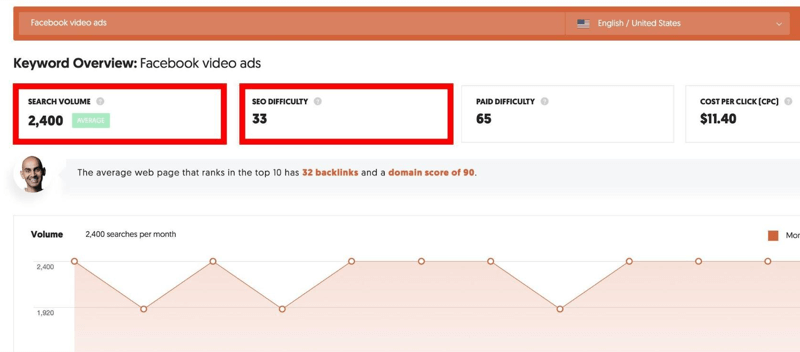
TubeBuddy (free and paid plans, starting at $9/month) is another must-have free tool for anyone using YouTube. It's a browser plugin that accesses the platform and gives you a whole host of powerful features. The one I want to focus on right now is their keyword planner.
Like Ubersuggest, you type in the keyword ideas and TubeBuddy will show:
- Search volumes
- How competitive the term is
- How well-optimized competing videos are
- Other related keyword ideas
The related keywords are where the real value lies.
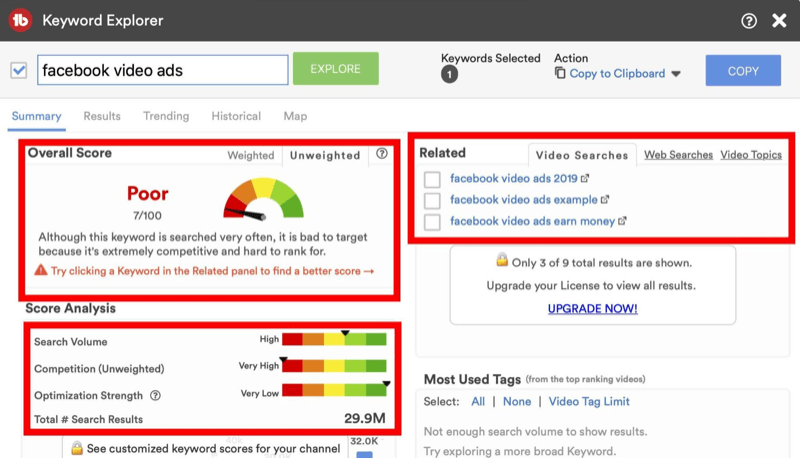
To use the TubeBuddy's keyword explorer, first you need to install the extension in your browser. Then click the toolbar icon, which is shown below.
![]()
From here, go down to Extension Tools and select Keyword Planner.
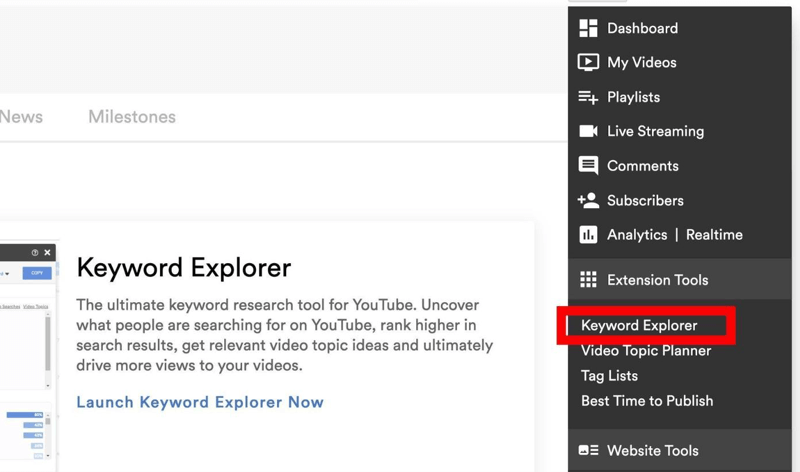
Now type in your keyword and click Explore.
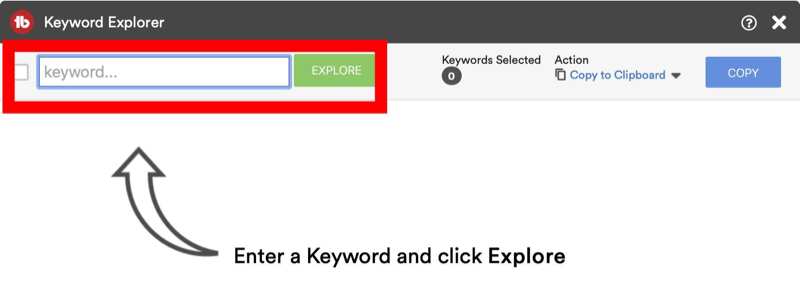
You'll see your score, score analysis, and related keywords. The related keywords will give you food for thought. Ideally, you're looking for a keyword with high search volume and low competition with poorly optimized videos, but these are rare. If you're a new or small channel, I advise approaching keywords that have low competition and a moderate search volume to get things moving.
Make a note of the best keywords; you'll be using them as part of your multi-level keyword strategy discussed later in this article.
Quora is a question-and-answer website. People type in their questions, and other people answer them. Enter your video title into the platform and check out the results. While Quora won't tell you how competitive the search term is, you can get an idea of how much interest there is for your title.
Are there lots of questions asked about it? How are they phrased? Are people providing lots of answers?
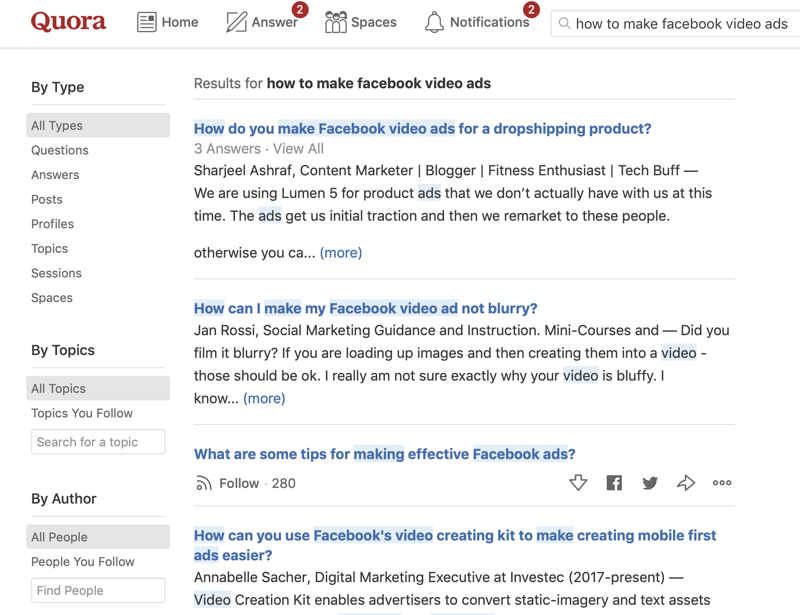
TubeBuddy and Ubersuggest lack the one thing Quora has on its side: the human connection. Sometimes Quora throws out a surprise or two with how you might structure your title. At the very least, it will give you an idea of what confuses the audience about your topic, which the other tools won't make as obvious.
Pro Tip: After you've published your video, go back and post it as an answer on Quora in your first 48 hours to drive up that YouTube watch time.
#4: Structure Your YouTube Video Titles to Appeal to Your Niche Viewers
To grow your YouTube channel, you need to improve the chances that anyone seeing your content while searching your niche clicks on it.
To do this, you need to structure your video titles to appeal to search queries. The more exact the title, the more relevant it is to the viewer, and the more relevant it is, the more clicks per impression your video will get.
Let's look at two different video titles: “How to Build an Automated Email Nurture Campaign Using HubSpot” and “Building an Automated Email Nurture Campaign.” The first title is very specific and tells the potential viewer a few things about the video:
- It's about building email nurture campaigns.
- It's for people using HubSpot.
Having HubSpot in the title makes it more likely to appear in search and alongside other videos about the same software and topic. This will result in a higher percentage of clicks from a colder audience because it's relevant. As long as you provide the right experience after the viewer hits Play, the audience retention and watch time should be high, too, because the content is in line with the title.

Discover Proven Marketing Strategies and Tips
Want to go even deeper with your marketing? Check out the Social Media Marketing Podcast! Publishing weekly since 2012, the Social Media Marketing Podcast helps you navigate the constantly changing marketing jungle, with expert interviews from marketing pros.
But don’t let the name fool you. This show is about a lot more than just social media marketing. With over 600 episodes and millions of downloads each year, this show has been a trusted source for marketers for well over a decade.
The second title, “Building an Automated Email Nurture Campaign,” is far too general to build a solid CTR. Not only will it be a lot harder to rank in search but also if someone who's using a different system than HubSpot clicks Play, the watch time will suffer because the content won't be relevant to them.
Your CTR could still be high but it won't work hand in hand with your content. So in this instance, a high CTR could be damaging as people hit Back and look for a video that matches their platform. This will impact your watch time and audience retention.
Usually, this is what happens when a video hits its peak and YouTube decides to promote it to a broader audience. It shouldn't be your goal to rank for more general topics from the start.
#5: Devise a Multi-Level Keyword Strategy to Help YouTube Videos Rank in Search
Once you've researched potential keywords for your video title, you want to make sure you use a multi-level keyword strategy in your title. This will help you get a higher CTR and rank your content in search.
Let's look at the video “How to Pitch Your Business in 60 Seconds” as an example. As you've probably guessed, it's about giving a 60-second elevator pitch.
The video title has a three-level keyword strategy.
Level 1: “How to Pitch Your Business in 60 Seconds.” This had very few but very relevant searches. There was less competition for the term, which meant it ranked, and because it was so relevant to the researched search terms, it received a high CTR, too.
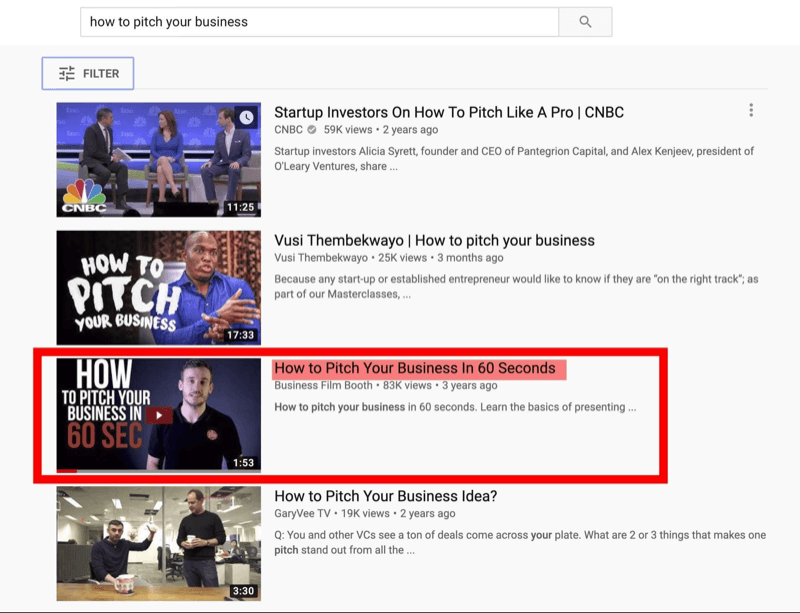
In its infancy, this particular video also had a high watch time and audience retention, which meant YouTube moved it up the ranks to our desired level-2 search term. It's worth noting that this took almost 9 months so it doesn't happen overnight for highly competitive terms.
Level 2: “How to Pitch Your Business.” This was very competitive with many monthly searches. The title remained relevant to the video's content, so the CTR remained high, as did the watch time. Eventually, this moved the video to the top spot on YouTube and Google search above videos with significantly more views.

Level 3: “How to Pitch.” This was the most competitive term, but it was also too general. People searching for videos about pitching tents or throwing a ball could see it, which could have damaged the CTR. In this case, we got lucky, because there are a lot more searches about pitching a business than a tent or baseball, so the CTR remained above 11%.
Eventually, the video did appear on page one for “How to Pitch” and was the only video with fewer than 100,000 views to do so. It's slowly moving down the ranks as more competition comes in from various niches but it's not a concern.

To get your videos in front of the right people who will click Play, you need to build these levels into your title. Once your initial subscribers have seen your video and YouTube begins to show it to others, the level-1 keyword means it will stand a chance of getting a few very targeted views and clicks.
The result of this is what propels it to your more competitive level-2 keyword—the one you really want. You can see from the image below just how long it can take to move from level 1 to level 2 and build your views.
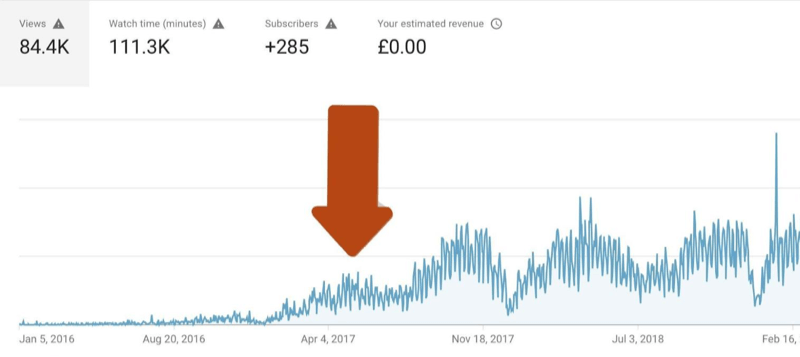
You don't need millions of impressions to start. CTR is a percentage, so if 100 people have your video put in front of them and 30 people hit Play, it signals to YouTube that so far, people are interested in the topic and they should show the video to a few more people.
As long as watch time and audience retention stay high after the click, the video will move up the ranks and you can start to appear for your level-2 keyword.
Remember to keep your video titles as targeted as you can so they're super-relevant to a smaller number of people. But also design your titles so they can scale up and compete for more traffic with more searched-for keywords that maintain your CTR.
#6: Create Eye-Catching YouTube Thumbnail Images
Imagine if Hollywood could only advertise movies using a single poster—nothing else. How seriously would they take that image? In YouTube land, your video thumbnail should get just as much consideration. It's the most powerful way to draw someone's eye to the title and boost your CTR.
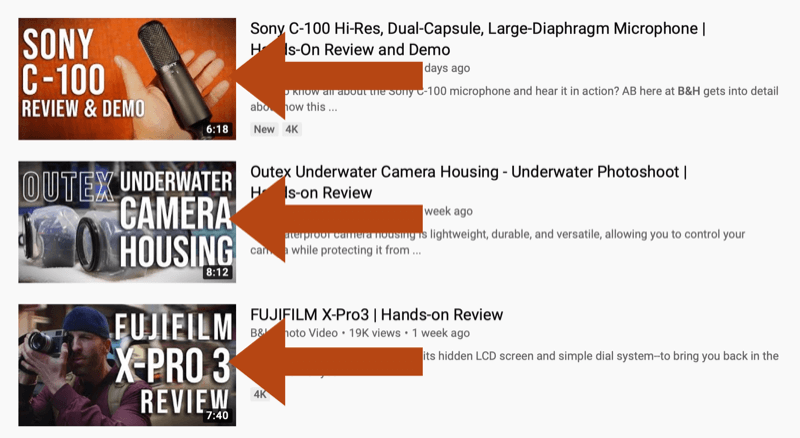
To understand the importance of thumbnails, you need to realize that your video isn't just competing against other videos on the same topic; it's competing against every other video on YouTube. You don't know where your content might end up.
To visualize this, it might end up in suggested views fighting against videos from all other niches. As you can see in the image below, suggested views is a very competitive place.
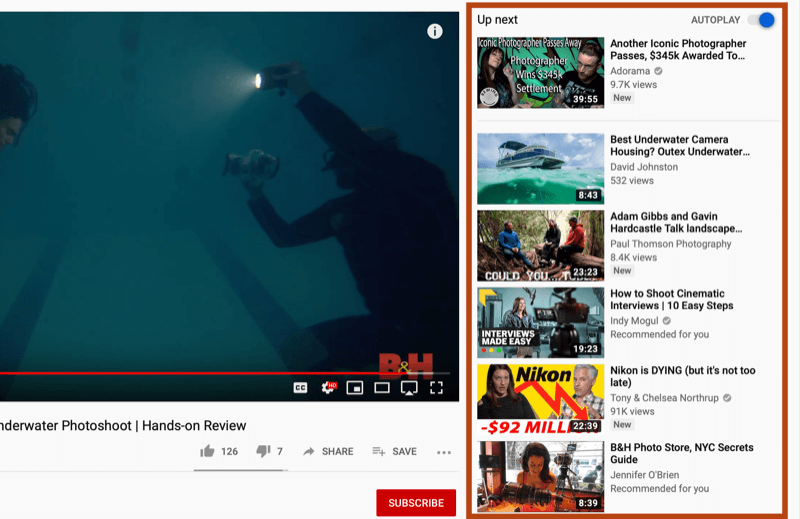
Your video could end up ranking in search, meaning you need a way to differentiate it from the hundreds of other videos on the topic or it could end up on the home screen, which is another level altogether.
Design Your YouTube Thumbnails to Stand Out
Your video's thumbnail is the key to increasing CTR. It's your chance to connect with viewers on a visual and emotional level that the YouTube algorithm won't ever understand. It's your film poster. With 90% of the top-performing videos on YouTube using custom thumbnails, you need to learn how to design them because the automated default thumbnail YouTube gives you will only hurt you.
YouTube provides a guide for thumbnails that will get clicks. They suggest including a human (usually the presenter), some text, and an emotional expression. The arrows below point out each of these criteria to show you how common this approach is.
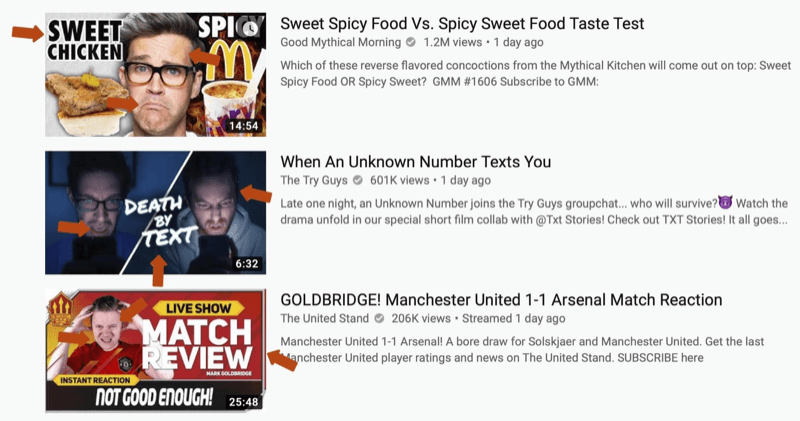
The issue with this is that once YouTube shared this guide, everyone followed it, as Brian G. Johnson recently noted. Brian scrapped this formula and just used a red image with bold text across the video with a contradictory statement on it. The result of the red image and text was a huge boost to his views because the thumbnail popped.

Your thumbnail needs to stand out and that doesn't mean copying what everyone else does.
Include a Person
The problem with not including a human is the amygdala—the part of the brain responsible for facial recognition. That's right, our brain has a special area specifically for remembering faces, not branding, text, or color.
As a result, many channels build recognition with a face on their thumbnails. I'd still recommend this method, especially for smaller channels. You can copy someone's style and branding but you can't clone them. After people watch a few videos and enjoy them, seeing a familiar face will no doubt boost your CTR the next time they see your content.
Add Thumbnail Text
When it comes to thumbnail text, you have a few options. Option one is to be matter-of-fact and say exactly what the video is about or shorten it with fewer words that complement the title.
Option two is to provoke or intrigue with headline architecture. Take the following thumbnail as an example. It's from a video about how YouTube now promotes longer videos.
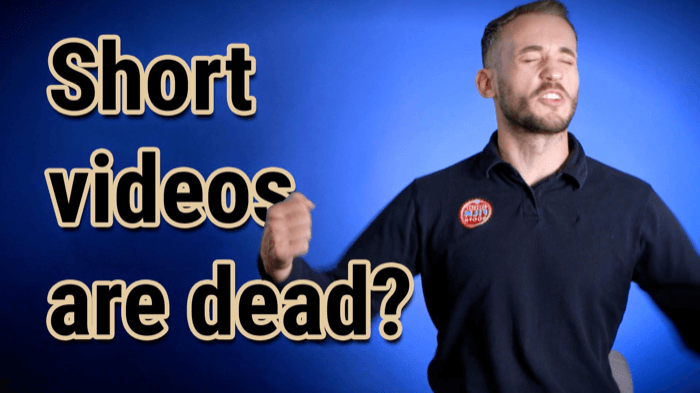
The matter-of-fact option would be to mirror the title: “The New Rules on Video Length.” The provocative option would be, “Short Videos Are Dead?” which then has some gaps filled in by the text title. You have to be careful to avoid creating clickbait but the viewer will decide that once they click Play.
Select Imagery That Evokes Emotion
There are several ways to express emotion through a thumbnail. The most common is with an over-the-top expression. Of course as a brand, you might not want to represent yourself this way. Another option is to find an image relevant to the content that could cause an emotional reaction, usually a story.
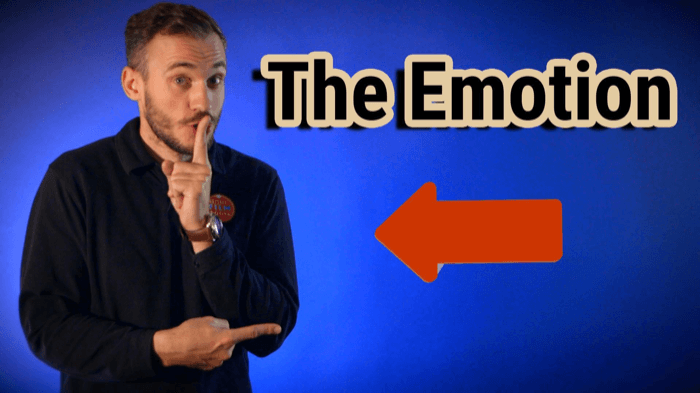
Tell a Story With Your Thumbnail
Consider telling a story with your thumbnail image. Give people a window into what your video is about or use one of the more intriguing and creative scenes from the video.
You'll notice the top YouTube channels now shoot their thumbnails specifically to help tell a story because pulling a still from a video might not always work for that purpose.
It's all about standing out to get more clicks so sometimes you have to take creative risks. Here's an example of a thumbnail story used in a video about paying to promote YouTube videos.
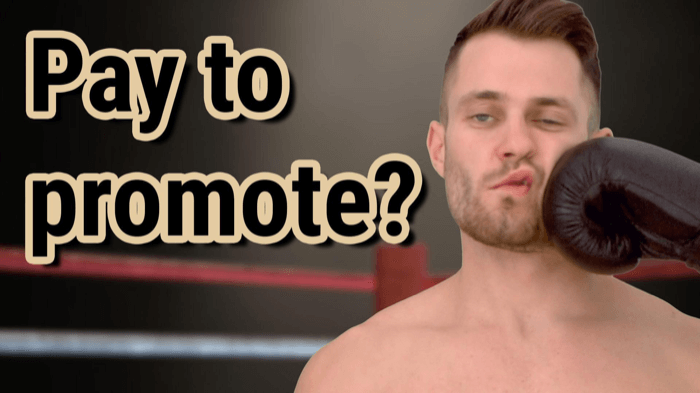
Thumbnail Branding and Layout
If someone enjoys one of your YouTube videos, you want them to discover more of your content. Using a consistent, branded look in your thumbnails will help people recognize your content in a competitive sea of other creators' videos.
Design a template with the same fonts and colors, keep it consistent, and add your story images to that.
Pro Tip: The bottom-right corner of the thumbnail will display the video length on mobile phones and obscure part of the thumbnail. Make sure you keep any vital text or image out of that area.
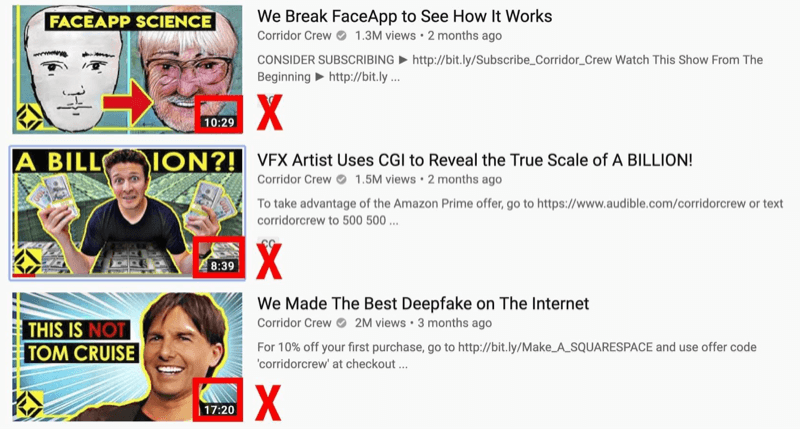
You can choose from many different tools to create your thumbnail. Photoshop is an obvious option. Make your image size 1920 x 1080 and start creating.
A free option is Canva. They have a series of rather slick thumbnail templates that you can edit to your own style. You can see a few of their templates below.
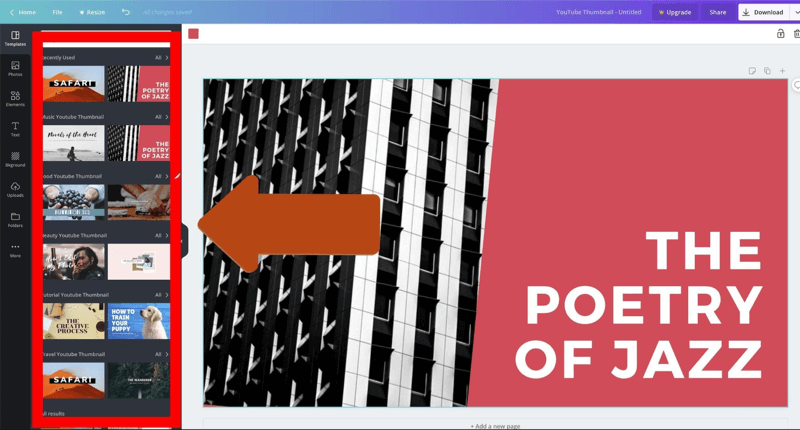
TubeBuddy has a thumbnail builder, too. While it's not going to win you any design awards, if you're smart about the main image you use, you don't need a degree in graphic design to make an impact.
Conclusion
You might have noticed this article focuses a lot on the first 48 hours of a video's life—that's when YouTube does a lot of its testing. Unfortunately for smaller channels, you can't rely on YouTube showing enough people your latest release for the stats to add up and make a difference, especially if you have a small subscriber base.
Hopefully, you've developed a following elsewhere, like an email list. You'll find that your most engaged audience—whether on Facebook, Twitter, email, and so on—will click on your video and boost its CTR on release and watch it longer.
Create a page on your site or blog that you devote to your latest video and then promote that as much as you can in the first 48 hours. Embedding a YouTube video on your site won't count as a click but sending people to a devoted blog or landing page with no other distractions will see a significantly higher watch time than on YouTube.
This watch time will send the right signals to YouTube to push your video out to more people. Your subscribers will boost the CTR on YouTube, and your other followers will help with the watch time on your website. If you've done everything discussed in this article, you should see your CTR increase and the views come in. And as long as your content is engaging, your channel will grow.
While the first 48 hours of your video's life are the most important, YouTube will test your content a little further down the line (rumored to be after 6 months) to give it a second chance. Go through your old videos and find those with high watch time and audience retention but low CTR. Improve the thumbnails, make sure your titles are searchable, and follow the multi-level keyword system. You may find your best-kept secrets finally get the recognition they deserve.
What do you think? Will you try this approach when naming your YouTube videos and designing your thumbnails? Share your thoughts in the comments below.
More articles on YouTube marketing:
- Discover different types of videos to create for a YouTube sales funnel.
- Find tips to get people to watch your YouTube videos to the end.
- Learn how to set up Google Analytics to analyze and assess the effectiveness of your YouTube marketing.
Attention Agency Owners, Brand Marketers, and Consultants

Introducing the Marketing Agency Show–our newest podcast designed to explore the struggles of agency marketers.
Join show host and agency owner, Brooke Sellas, as she interviews agency marketers and digs deep into their biggest challenges. Explore topics like navigating rough economic times, leveraging AI, service diversification, client acquisition, and much more.
Just pull up your favorite podcast app, search for Marketing Agency Show and start listening. Or click the button below for more information.

